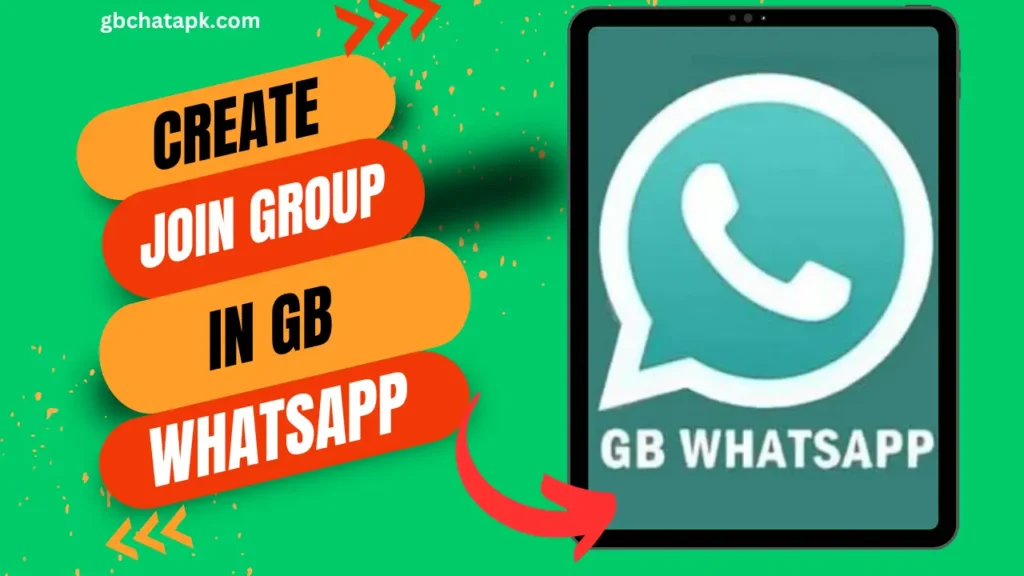
GB WhatsApp is a popular messaging app that offers users a wide range of features and customization options.
One of the critical functionalities of GB WhatsApp is the ability to create and participate in groups.
In this comprehensive guide, I will take you through everything you need to master group creation and participation on GB WhatsApp.
What are GB WhatsApp groups?
Groups are virtual spaces where like-minded individuals can share information, discuss topics of interest, and connect.
These groups can be created by anyone who has the app installed on their device. GB WhatsApp groups can have varying sizes, ranging from small intimate circles to large communities with thousands of members.
These groups can be public or private, depending on the preferences of the group creator.
Benefits of participating in groups
Participating in groups can bring several benefits. Firstly, it lets you connect with people with similar interests or goals.
Whether you’re passionate about a hobby, a professional field, or a social cause, there’s likely to be a group where you can find like-minded individuals.
This sense of community can be precious, as it allows learning from others, exchanging ideas, and finding support.
Secondly, groups can serve as a valuable source of information. Group members often share articles, news updates, and resources related to the group’s topic of interest.
This can save you time and effort in finding relevant information as the group members curate and filter the content. Additionally, group discussions can provide insights and perspectives you may have yet to consider.
Lastly, participating in groups can enhance your networking opportunities. You have the chance to connect with individuals who may have similar professional or personal goals.
This can lead to collaborations, partnerships, or even friendships that enrich your personal and professional life.
Tips for creating a successful GB WhatsApp group
Creating a successful group requires careful planning and consideration. Here are some tips to help you get started:
- Define the purpose and goals of your group: Before creating the group, clearly define what it is meant to achieve. Are you creating a group for networking, information sharing, or socializing? A clear purpose will attract members genuinely interested in the group’s topic.
- Please choose an appropriate name and description: The name and description of your group should reflect its purpose and give potential members an idea of what to expect. Avoid generic names and descriptions that do not provide any context.
- Determine the group’s privacy settings: Decide whether you want your group to be public or private. Public groups allow anyone to join, while private groups require an invitation or approval from the group admin. Consider the nature of your group and the level of privacy you want to maintain.
- Set clear rules and guidelines: Establishing rules and guidelines will help maintain a healthy and respectful group environment. Communicate these rules to group members and enforce them consistently.
- Be an active and engaged group admin: As the group admin, your role is crucial in setting the tone and facilitating discussions. Be active in the group, initiate conversations, and encourage participation from all members.
- Encourage member participation: A successful group is one where all members actively participate. Encourage members to share their thoughts, ask questions, and contribute to discussions. This will help create a vibrant and engaging community.
Guidelines for participating in groups
Participating in groups also comes with specific responsibilities. Here are some guidelines to help you navigate group participation effectively:
- Respect the group’s purpose and rules: Make sure you understand and respect the group’s purpose and any rules or guidelines set by the group admin. Stay on topic and avoid sharing irrelevant or spammy content.
- Be mindful of your language and tone: Remember that your words impact others. Be respectful and considerate, and avoid using personal attacks or offensive language. Treat others the way you would like to be treated.
- Contribute meaningfully: When participating in group discussions, aim to contribute meaningfully. Share your knowledge, experiences, and insights that can benefit the group. Avoid one-word responses or messages that do not add value to the conversation.
- Avoid excessive self-promotion: While sharing relevant content or resources is acceptable, avoid it. Constantly promoting your products, services, or websites can be seen as spammy and may lead to members leaving the group.
- Respect privacy and confidentiality: Be mindful of the privacy and confidentiality of other group members. Do not share personal information or private conversations outside the group without explicit permission.
- Resolve conflicts respectfully: In any group, conflicts may arise. If you disagree with another member, address the issue respectfully and seek a resolution. Avoid personal attacks or escalating tensions within the group.
Managing GB WhatsApp group settings
As a group admin, it’s essential to familiarize yourself with the various settings and options available to manage your GB WhatsApp group effectively. Here are some key settings to consider:
- Group info: This section lets you view and edit the group’s name, description, and profile picture. Make sure the information accurately reflects the purpose and identity of the group.
- Group settings: In this section, you can manage privacy settings, such as who can join the group and who can see its members. You can also choose whether only admins can send messages or if all members can contribute.
- Admin controls: As an admin, you have additional controls to manage the group. You can promote or demote members to admin status, remove members from the group, and restrict specific actions for members.
- Message settings: You can control who can send messages in the group, whether members can edit or delete their messages, and if media and documents can be shared.
- Group media visibility: This setting allows you to choose whether media shared in the group is visible to all members or only to admins.
- Group link: it provides a unique link for each group, which can be shared with others to invite them to join. You can generate, reset, or revoke this link as needed.
Etiquette and best practices for group communication
Effective group communication requires adherence to certain etiquette and best practices. Here are some tips to help you communicate respectfully and efficiently:
- Use appropriate language and tone: Choose your words carefully and be mindful of the tone you use. Avoid using all caps, excessive exclamation marks, or offensive language. Treat others with respect and courtesy.
- Keep messages concise and relevant: In group conversations, it’s essential to keep your messages concise and relevant. Long, rambling messages can be overwhelming for other members. Stick to the topic at hand and avoid deviating into unrelated discussions.
- Avoid excessive emojis and stickers: While emojis and stickers can add personality to your messages, using them excessively can make them challenging to read and comprehend. Use them sparingly and when they enhance the meaning of your message.
- Don’t spam the group: Avoid sending multiple consecutive messages or flooding the group with unnecessary content. Respect others’ time and attention by consolidating your messages or using reply threads when appropriate.
- Use reply threads effectively: You can reply to specific messages within a thread. Utilize this feature to keep conversations organized and easy to follow. Reply directly to the message you are referencing to provide context.
- Stay on topic: Group conversations can easily veer off-topic. Make an effort to stay on topic and avoid introducing unrelated discussions. Consider creating a separate thread or starting a conversation to discuss a different topic.
Advanced features and customization options
it offers several advanced features and customization options to enhance your group experience. Here are some notable features worth exploring:
- Group announcements: As an admin, you can send group announcements at the top of the chat for all members to see. This is useful for important updates or announcements that need immediate attention.
- Mentions and replies: You can mention specific members in your messages by typing ‘@’ followed by their name. This notifies the mentioned members and makes identifying messages directed at them easier.
- Group settings customization: It provides many group customization options. You can change the group’s display picture, customize the notification settings, and even choose a unique theme for the group.
- Group media sharing: It lets you share various media types, including photos, videos, documents, and voice messages. Take advantage of these features to enhance communication and share relevant content with the group.
- Polls and surveys: It allows you to create polls and surveys within the group. This is a great way to gather opinions, make group decisions, and collaboratively engage members.
- Group backups: It offers the option to back up your group chats and media to cloud storage. This ensures that your group data is safe and can be restored.
Troubleshooting common issues in GB WhatsApp groups
While GB WhatsApp is a powerful messaging app, it can sometimes encounter issues. Here are some common problems that may arise in GB WhatsApp groups and how to troubleshoot them:
- Messages not delivered: Check your internet connection to see if your messages have not been delivered to the group. Poor connectivity can prevent messages from reaching the group. Restarting your device or reinstalling the app may also resolve the issue.
- Members unable to join the group: If members are having trouble, ensure that the group’s privacy settings allow new members to join. Double-check the group link and make sure it is valid. If the issue persists, try revoking and generating a new group link.
- Group notifications not working: Check your device’s notification settings if you’re not receiving group notifications. Ensure notifications are enabled and the necessary permissions are granted. Restarting your device or reinstalling the app can also help resolve notification issues.
- Excessive spam or unwanted messages: If your group receives a lot of spam or unwanted messages, consider changing the group’s privacy settings to require admin approval for new members. You can also remove members who consistently violate group rules or guidelines.
- Difficulty managing a large group: Managing a large group can be challenging. Consider promoting trusted members to admin status to help with moderation and member management. Utilize the various group settings and customization options to streamline communication and reduce clutter.
Conclusion and final thoughts
Mastering group creation and participation can open up a world of possibilities for connecting with others, sharing knowledge, and building a community.
Following the tips, guidelines, and best practices outlined in this comprehensive guide, you can create and participate in successful groups that enrich your personal and professional life.
![GB WhatsApp APK Download July 2024 [Official]](https://gbchatapk.com/wp-content/uploads/2023/12/cropped-logo-2.jpg)
